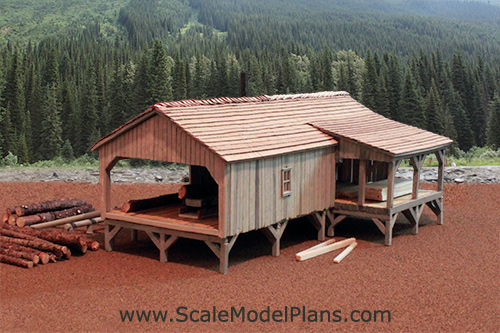Devon,
Flow chart is pretty similar and basic to most saw mills no matter the size of operation. Unfortunatly in modeling, especially garden scale, the mills are always way undersize for a railroad operation, it would take mills that size a week to cut enough lumber to fill a boxcar. That last is just a personel gripe never mind it.
Looks like the flow has been discussed some already but my 2 cents.
Logs into the mill.
From a pond there has to be some kind of Jack slide or chute to pull the logs to the cutting deck. This is done with a ladder chain running like a conveyor belt or a tongs and cable from a powered spool to pull them up. In larger mills there will be a water wash to spray loose bark, rocks, mud, etc from the logs on their way up the slide. And don’t forget the “Pond Monkey”
A lot of smaller mills used a rollway arrangement to bring the logs to the cutting deck. Either by cross-hauling the logs from the ground to the cutting deck up a ramp or using an elevated cold-deck and rolling the logs down onto the cutting deck.
From the cutting deck the logs are rolled onto the carriage and oriented in the most suitable cutting position and “dogged” down. The carriage is where the “Setter” works, riding the carraige back and forth and taking dimensional info from the “Sawyer” and adjusting “setting” the width of the cuts for 4 quarter, 8 quarter, etc.
The sawyer puts the saws and carriage in motion when he is satisfied that everything is ready. He is also the one responsable for “reading” the log and getting the most available lumber with the least waste from each log.
From the head rig the offcuts or slabs, or blanks are rolled either by hand or power rolls to the Edger table where a series of circular saws are set to cut dimensional lumber such as 6 inch or 8 inch etc. Usually there will be a couple of blade set ups on the edger so the edgerman can get the most out of the slab depending on it’s width.
From here it can go either to the Green Chain or the Cut Off tables depending on several factors such as; At smaller mills the logs are usually already in lengths that the want to deal with such as 16 or 24 foot so the lumber goes from Edger to the green chain. In larger operations they usually Cut 32 ft logs so the lumber is sent from the Edger to the Cut Off saw to be knocked down to the lengths they are wanting such as a couple of 16’s or maybe four 8’s etc. And remember a log is always cut long so that full 8 foot lumber can be cut from it no matter the breakdown. A 32 ft log will usually be cut 32’ 6 or 8 inches. After cut off ted boards are sent to the Green Chain.
As the boards make their way down the Green Chain they are (at least in the old days) graded for quality and marked with a crayon then the pullers grab the boards and stack them on racks according to size, 2x4 or 2x6 etc., and grade From there they are moved to the drying yard by any of several methods (again depending on several variables) and are stacked and stickered for drying before moving on to whatever they are going to be used for.
Lots of variables in all of the above depending on mill, size, location, budget, timber size, era, etc.
Here is a video we made a few years ago of a small steam operated sawmill, no railroad involved but it shows quite well the operations discussed above. In the vid I think you will see that all the waste from the edger is sent to a cut off saw and cut into piecesand these pieces along with the sawdust are all sent to the boiler as fuel, nothing is wasted.
Look here.
https://www.youtube.com/watch?v=CGuR3WN8PCs&feature=youtu.be
Looking forward to seeing your build.
Rick




